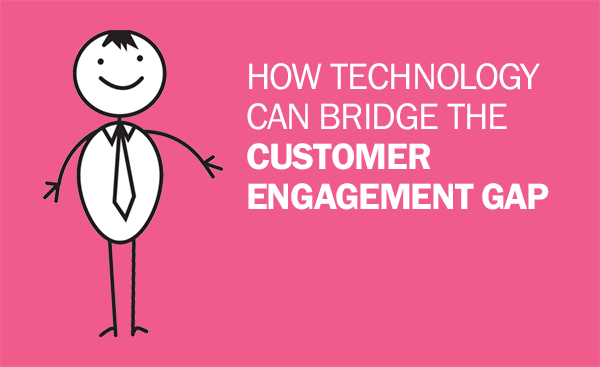How technology can bridge the customer engagement gap

In a previous blog post I highlighted the growing gap between customers and companies, and how this lack of understanding is undermining efforts to improve customer experience.
This was demonstrated by the Eptica Study: The Power of Linguistics in Customer Service. Based on research with both consumers and agents, it sought to identify the frustrations that are undermining the UK customer experience. The key finding was that consumers are becoming increasingly frustrated at not being understood, and are voting with their feet by switching supplier, while contact center agents faced with a tidal wave of emails and tweets empathize but can do nothing to help. You can read the original post here.
In the research agents pinpointed improved technology as a way of making their jobs easier and increasing productivity. They also understood it would have a positive impact on the customer experience, helping bridge the engagement gap.
Why is the understanding gap there?
In this post I wanted to outline some of the ways that technology can help. However, let’s first look at why the gap has developed.
Essentially there are two reasons – customers have got more demanding, and have no compunction in contacting an organization if they have received poor service, and secondly, they have more and more channels to choose from. So there are a greater number of written contacts for companies to deal with, across multiple channels, often with stretched resources. Even relatively small companies can be receiving hundreds of emails a day, which translates into tens of thousands or even millions per year.
Add to this that written text is difficult to understand fully. There is none of the visual or verbal context that participants can follow when communicating face to face or over the telephone. Individual digital channels also have their own drawbacks when it comes to understanding. Email is not a continuous conversation, but stop/start as messages are sent between consumer and agent, often making it difficult to follow the flow. Any delay can also add to frustrations as the conversation is prolonged. Tweets are obviously limited to 140 characters, which mean it can be impossible to satisfactorily answer a complex query, even if multiple tweets are used. Digital channels are used by people from across every demographic, and agents often complain that they can glean very little context from an email or other message, meaning they have very little understanding of the consumer as an individual or their relationship with the company.
Additionally, many companies run different channels as silos, so there is no integration– meaning an agent doesn’t know that the angry customer that is now emailing is frustrated because the tweet they sent two days ago still hasn’t been answered.
Using technology to bridge the gap
Technology may be behind the rise in multichannel interactions, but it can also help tame the monster it has created. For example linguistics, the scientific study of language, helps businesses by automatically analyzing incoming interactions, prioritizing them based on tone, forwarding to the most relevant agent or department and suggesting relevant answers.
Let’s take the example of an incoming email and show how technology can improve the process for all involved.
1. EMAIL ARRIVES, AND IS AUTOMATICALLY ANALYSED FOR:
A. Type of query – does it refer to an outstanding order, a delivery, a return?
B. Tone – is the customer happy or sad?
C. Other information, such as email addresses or phone numbers that can be used to identify if the email is from an existing customer or not. If so, can it be matched to customer records?
2. WORKFLOW THEN:
A. Prioritizes the interaction dependent on the tone or severity of the issue.
B. Sends it to the best available agent to answer it. This could be based on language, experience or particular team.
C. Alternatively, if the query is more complex it could be sent to a subject matter expert within the company (such as a product manager) who has the knowledge to provide an answer.
3. AT THE SAME TIME THE TECHNOLOGY AUTOMATICALLY SEARCHES THE CENTRALISED KNOWLEDGE BASE:
A. The most relevant answer is selected and then sent to the agent handling the query as a template.
B. The agent also has access to the customer record to see the full history of the relationship.
C. The agent then personalizes the answer and sends it to the customer.
D. The agent can then rate the response the knowledge base provided – was it adequate or does it need additional information adding? If so, feedback is sent and the answer is updated and approved by the relevant manager.
4. INTERACTION ANALYSIS FOR VOICE OF THE CUSTOMER PROGRAMMES:
A. By analyzing incoming interactions companies have a real-time view into the customer experience. How happy are customers? What are they asking about? What words or phrases are repeated – and do they vary from channel to channel?
B. This can be used as a real-time warning system of problems, such as a network outage at a telecoms company or a fault on a website.
C. It also flows into Voice of the Customer programs, providing deep insight that can be used to make longer term, strategic and tactical changes to how businesses operate and the products and services they provide
As you can see technology can do two things – it deepens understanding between agents and customers, and at the same time it automates much of the process. This increases efficiency and means customers receive a response that answers their question quickly and satisfactorily. This increases engagement, improves loyalty and creates long-term relationships that benefit both sides. To find out more and to read the full Eptica Study, click here.







Comments